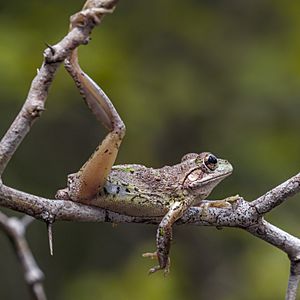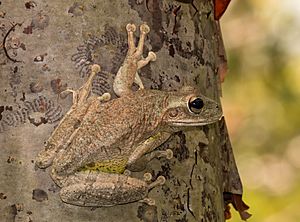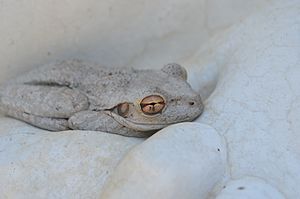Cuban tree frog facts for kids
Quick facts for kids Cuban tree frog |
|
|---|---|
 |
|
| On Grand Cayman | |
| Conservation status | |
| Scientific classification | |
| Synonyms | |
|


The Cuban tree frog (Osteopilus septentrionalis) is a big type of tree frog. It naturally lives in Cuba, the Bahamas, and the Cayman Islands. But it has also spread to many other places in the Americas. This frog eats many different things and can live well in cities. This has made it a very invasive species. It now lives in places like Florida, the Hawaiian island of Oahu, and other Caribbean Islands.
These tree frogs can be from 2 to 5.5 inches (5 to 12.7 cm) long. Because they are so big, Cuban tree frogs can eat many different animals. They especially like to eat smaller native tree frogs. When Cuban tree frogs are removed from an area, the number of native tree frogs often goes up. The young Cuban tree frogs (tadpoles) also compete with native frog tadpoles for food. This can make native tadpoles smaller and grow slower.
Contents
What Does a Cuban Tree Frog Look Like?
Cuban tree frogs are the biggest tree frogs in North America. They can grow from 2 to 5.5 inches (5 to 12.7 cm) long. Most Cuban tree frogs are gray, brown, or green. Younger frogs often have more green color than adult frogs. These frogs have rough, bumpy skin with blotchy patterns. Cuban tree frogs can change their skin color and pattern to hide themselves.
The inside of their thighs is bright yellow. This color helps to confuse predators when the frog jumps away. Their toes have sticky pads. These pads help them climb and live in trees. The skin on their heads is joined to their skull. If you gently rub the head of an adult frog between its eyes, the skin will not move. This special feature helps them save water. Cuban tree frogs can also release a sticky, toxic liquid from their skin. If this liquid gets into a person's eyes, it can cause a burning feeling.
How Do Cuban Tree Frogs Behave?
Cuban tree frogs are mostly active at night. They sleep during the day and prefer to hunt and breed after the sun goes down. These tree frogs are very hungry. They will eat almost anything that fits in their mouth, even smaller frogs. Sometimes, they climb up utility poles to hunt. This can cause power outages by short-circuiting electrical switches. Cuban tree frogs sometimes sleep on palm trees or in potted plants. This can help them spread to new places when these plants are moved.
What is the Life Cycle of a Cuban Tree Frog?
Like most frogs, female Cuban tree frogs are larger than males. During the breeding season, male frogs have a black pad on their hand or wrist. This pad helps them hold onto the female during amplexus (when frogs mate).
Cuban tree frogs can breed all year long if the conditions are right. They prefer to breed during the wetter months. The best conditions for breeding are warm temperatures (around 81.5°F or 27.5°C) with high humidity (97.8%) and rain. A female frog can lay hundreds to over a thousand eggs in one clutch (group of eggs). The eggs can hatch in less than 30 hours. The tadpoles can fully grow into froglets in about one month.
Cuban tree frog tadpoles have wide tails and two rows of teeth on the top of their mouths. They have four rows of teeth on the bottom. Tadpoles eat algae. Sometimes, they will eat other tadpoles or even very young froglets. After they change into froglets, they are about 0.55 to 0.67 inches long.
Where Do Cuban Tree Frogs Live?
The Cuban tree frog is originally from Cuba, the Bahamas, and the Cayman Islands. This large frog has been brought to Puerto Rico, the US Virgin Islands, and the British Virgin Islands. It is not clear if the species was always in the Key West area of Florida, or if it was brought there. These frogs were first seen in the 1930s. It is thought they arrived on cargo ships in the 1800s. They can live in brackish water (water that is a mix of fresh and salt water). This might have helped them spread to different islands.
The spread of Cuban tree frogs into mainland Florida is believed to have been helped by the building of State Road A1A in the 1940s. The species now lives in southern Florida and parts of the panhandle region. They can be found as far north as South Carolina.
Cuban tree frogs are known to travel hidden in shipments of potted plants, other plants, packages, boats, and vehicles. Once they arrive in a new place, they become an invasive species. In Puerto Rico, they eat the common coquí (Eleutherodactylus coqui), which is a native frog. Cuban tree frogs are good at colonizing new areas. They lay many eggs, grow up quickly, eat many different things, and can live well with humans. Also, the toxic liquid from their skin helps protect them from predators.
Cuban tree frogs live in many different places. These include estuaries (where rivers meet the sea), suburban areas, small towns, and farms, especially those with exotic plants. They also live in lowland forests and swamps. Within these places, they like damp, shady spots. You can often find them around shrubs and trees, near cisterns (water tanks), rain barrels, and buildings. They like to be near medium and large trees and prefer temperatures above 10 degrees Celsius (50 degrees Fahrenheit).
Why is Conservation Important?
This large frog directly harms native ecosystems. It eats native frogs, lizards, and snakes. It threatens the biodiversity (the variety of life) of the areas it spreads to. This is because it causes native tree frog populations to go down. These effects are most noticeable in cities and suburbs. In these areas, native tree frogs like the American green tree frog (Hyla cinerea) and the squirrel treefrog (Hyla squirella) are quickly disappearing.
The Cuban tree frog has spread all over Florida. It is also found in small groups as far north as southern Georgia. It can accidentally travel on vehicles or in plants. This helps it spread to new areas. It has even been found as far north and west as Saskatchewan, Canada. Because of its impact on biodiversity, some experts suggest that people humanely remove these frogs when they are found in new habitats.
Cuban Tree Frogs as Pets
Cuban tree frogs are often sold as pets in the United States. They are not expensive. If cared for properly, they can live for five to ten years. They will eat any animal that fits in their mouths. This means they might eat other frogs if there is a big size difference between them in the same tank.
Their toxic mucus can irritate eyes and cause allergic reactions. Because of this, this species is not the best pet, especially for children. The spread of Cuban tree frogs to Oahu (Hawaii) is thought to have happened because people accidentally or purposely released pets. Because of this, it is now against the law to sell Cuban tree frogs in Hawaii. If someone is caught importing a Cuban tree frog, they could face a large fine and time in jail.
See also
 In Spanish: Osteopilus septentrionalis para niños
In Spanish: Osteopilus septentrionalis para niños


